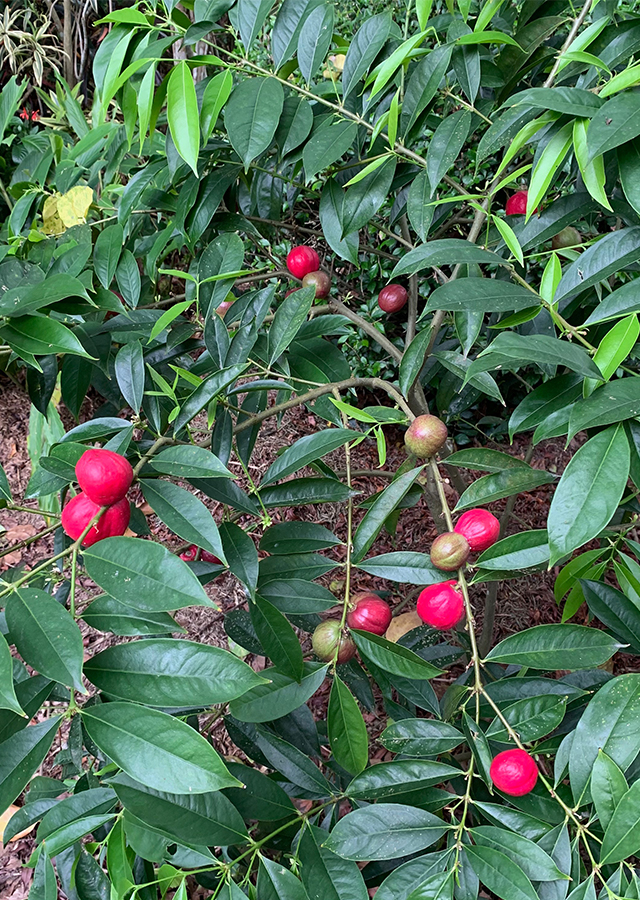God's Crown
Phaleria macrocarpa (Scheff.) Boerl.
Thymelaeaceae
Location in our garden
Principal



Synonym
Drymispermum macrocarpum Scheff.
Phaleria calantha Gilg.
Phaleria papuana Warb. ex K.Schum. & Lauterb.
Habitus
Trees. A laticiferous, small evergreen perennial tree, growing up to 18 m high.
Part Used
Leaves
Fruit
Growing Requirements
Full Sunshine
Need Shade
Habitat
Terrestrial
Overview
Phaleria macrocarpa is endemic to Indonesia and Malaysia and as a medicinal herb. In Papua New Guinea, Papua, Java and elsewhere in Indonesia, it is cultivated. P. macrocarpa extracts have been used in traditional medicine for years and have also been scientifically tested and recorded for a variety of useful medicinal properties.
Vernacular Names
Mahkota dewa (Malaysia), Huang kuang (Chinese), King of drug/Makuto queen/Pau (English), Makuto rojo (Japanese).
Agroecology
Phaleria macrocarpa is an Indonesian plant which grows on the island of Papua in tropical areas. It is found in forests of primary and secondary
importance. It grows between 10 and 1,200 m above sea level with a productive age ranging from 10 to 20 years.
Morphology
- Root - taproot, 1 m long straight root exuding sap, rooted saddle and golden brown.
- Stems - erect, cylindrical, up to about 15 cm of diameter, smooth or slightly wrinkled, brownish bark.
- Leaves - decussive or opposite, 5 mm long petiole, dark green, blade ovate-oblong, elliptical-oblong or oblong-lanceolate, 10-25 cm x 3-10 cm, pointed apex.
- Flowers - inflorescence terminal and axillary, sometimes cauliflorous, with 1-5 peduncles in each axis, bisexual, corolla tube glabrous, white
- Fruit - simple, fleshy drupe with 1-2 seeds, subglobose to broadly ellipsoid or rounded,green and becoming glossy red-maroon when ripe.
- Seed - subglobose or slightly ovate, about 1.5 cm x 1.3 cm, brown in color, anatropous.
Cultivation
- Generative propagation is by seed or by vegetative propagation (grafting).
- When they are 8-12 months old, plants grown from seed bear the first flower and the first fruit can be harvested 2-3 months later.
Chemical Constituents
- Phalerin, Gallic acid, Mahkoside A, Dodecanoic acid, Palmintic acid, Des-acetyl flavicordin-A, Lignans, Ethyl stearate, Magniferin.
- The bark and fruits: Saponins, Alkaloids, Polyphenolics, Phenols (Rutin, Cathecol), Flavonoids, Tannins, Kaempferol, Myricetin, Naringin, Quercitin.
Traditional Medicinal Uses
- P. macrocarpa leaves and fruits are mainly used against breast cancer and brain tumors.
- Seed egg shells are used in the treatment of cancer of the cervix, lung diseases, liver and heart diseases.
- Leaves include components that treat impotence, diseases of the blood, asthma, tumors and diabetes mellitus.
- P. macrocarpa fruit extracts have been found to reduce post-prandial hyperglycemia (excessive glucose levels).
- P. macrocarpa leaves and seeds are found to have profound antibacterial activity.
- It is now gaining significance in Indonesia as a medicinal plant. P.macrocarpa content is first dried in the shade for healthy use and then dried out by sun or fire. A dried peel and pulp decoction of the ripe fruit with added sugar is made into dried instant tea, which is commercially manufactured and distributed. It is taken alone as a health drink in hot water or in a decoction with ground-dried Andrographis paniculata leaves, Gynura pseudochina leaves and tubers and Curcuma zedoria tubers. Roscoe to treat a range of complaints including hepatitis, diabetes, rheumatism, cancer, hypertension and heart disorders.
- For the treatment of skin diseases and disorders, ground, fire-dried seeds of P. macrocarpa combined with coconut oil and ground dried leaves and tubers of the species are used as an ointment.
- Leaf decoctions are used against allergies, tumors and dysentery.
- The fruit of P. macrocarpa is astringent.
- Fruit and leaf extracts have shown antihistaminic activity.
Part Used
Reference Sources
- Brink, M. & R.P. Escobin (eds.). (2003). Plant Resources of South-East Asia No. 17 Fibre Plants. PROSEA Foundation, Bogor.

